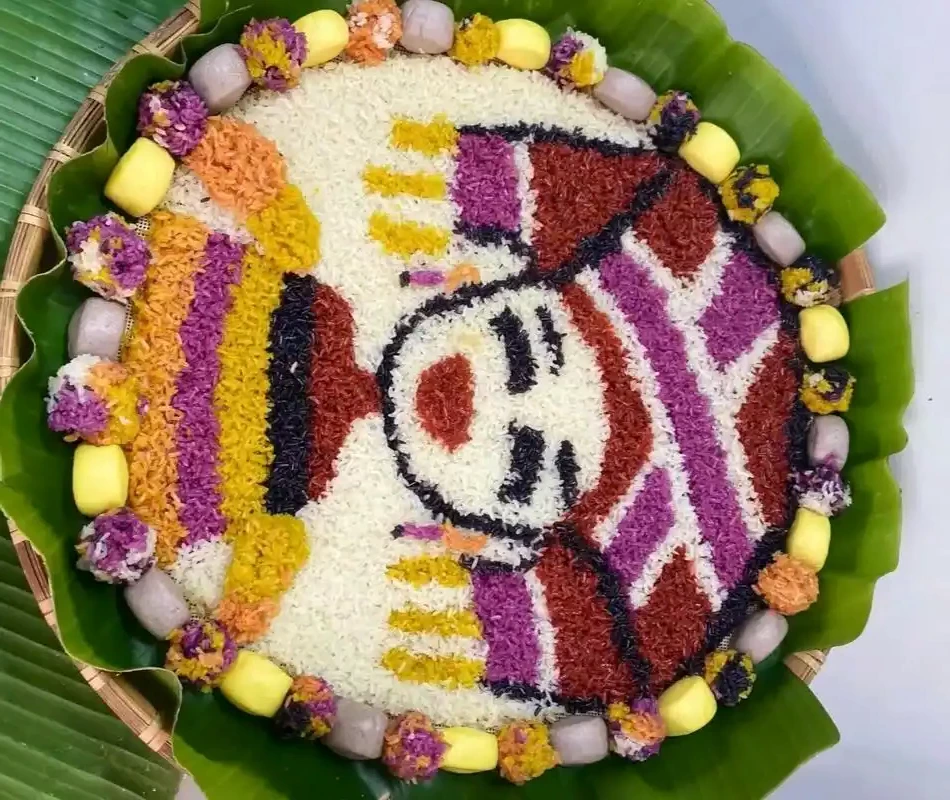Les délices vibrants du riz gluant à cinq couleurs du Yunnan: Une perspective culinaire
Introduction:
En tant que passionné de nourriture et praticien, I have always been drawn to the unique and diverse culinary traditions of China. One such tradition that has captured my attention is the Five-Color Glutinous Rice from Dali City, Province du Yunnan. This traditional dish, deeply rooted in the culture of the Zhuang people, is not only a feast for the palate but also a celebration of color and heritage. Let’s delve into the origins, signification culturelle, ingrédients, and the culinary artistry that goes into creating this vibrant dish.
Origines et fond culturel:
The Five-Color Glutinous Rice is a traditional Zhuang ethnic delicacy, particularly associated with the Qingming Festival. It symbolizes the renewal of life and the changing seasons, as well as the harmony between humans and nature. The dish is a testament to the Zhuang people’s deep connection with their environment, using natural plant dyes to create a dish that is as beautiful as it is delicious.
Ingrédients et préparation:
The making of Five-Color Glutinous Rice is a labor of love and a display of culinary skill. The key ingredients are glutinous rice and natural plant dyes, which include:
1. Red Blue Grass (Red): This plant provides a rich, deep red hue to the rice, symbolizing prosperity and good fortune.
2. Yellow Ginger (Yellow): Known for its vibrant yellow color, it represents happiness and warmth.
3. Purple Perilla (Purple): This plant imparts a regal purple shade, signifying nobility and grace.
The process begins with soaking the glutinous rice separately in water infused with each of these natural dyes. The rice absorbs the color over time, transforming into a palette of colors that are then combined to create a stunning visual effect.
Goût et texture:
The Five-Color Glutinous Rice boasts a unique texture that is both sticky and chewy, characteristic of glutinous rice. The natural dyes do not alter the taste of the rice, which retains its natural sweetness and subtle earthy flavor. The dish is often served with a side of sugar or honey, enhancing its sweetness and complementing the flavors of the rice.
Description visuelle:
The Five-Color Glutinous Rice is a sight to behold. Each grain of rice is individually dyed, creating a harmonious blend of colors that resemble a colorful tapestry. The red, jaune, and purple hues are vibrant and distinct, making each serving a work of art. The dish is often presented in a conical shape, further enhancing its visual appeal.
Plats représentatifs et utilisations culinaires:
While the Five-Color Glutinous Rice can be enjoyed on its own, it is also a versatile ingredient that can be incorporated into various dishes. It can be used as a filling for rice dumplings, added to desserts, or served as a side dish with savory meats and vegetables. Its natural colors make it a popular choice for festive occasions and special celebrations.
Caractéristiques culinaires:
The Five-Color Glutinous Rice is not just a dish; it is a culinary experience that encapsulates the essence of the Zhuang culture. Its characteristics include:
1. Natural Ingredients: The use of natural plant dyes is a testament to the Zhuang people’s respect for nature and their sustainable practices.
2. Cultural Significance: The dish is steeped in tradition and carries deep cultural meanings, making it more than just food.
3. Visual Impact: The vibrant colors and presentation make it a feast for the eyes as well as the palate.
4. Versatility: The dish can be enjoyed in various forms, from a simple snack to a centerpiece at a banquet.
Conclusion:
The Five-Color Glutinous Rice from Dali City, Yunnan, is a culinary gem that offers a taste of history and a glimpse into the rich culture of the Zhuang people. It is a dish that celebrates the beauty of nature, the art of cooking, and the joy of sharing food with loved ones. En tant que praticien de l'alimentation, I am honored to share this vibrant tradition with the world and encourage others to explore the diverse flavors and colors of Chinese cuisine.
